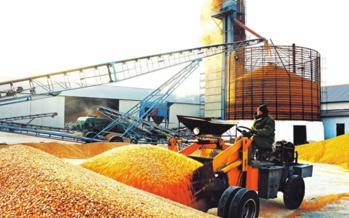Increased grain production drives global food prices
2023-09-23 19:08:36
 Recently, the United Nations Food and Agriculture Organization of the United States released its August average global food price index, a year-on-year decrease of 5.1% compared with August last year and a decrease of 1.9% compared with the previous month in July. Nie Fengying, a researcher at the Institute of Agricultural Information of the Chinese Academy of Agricultural Sciences, accepts this reporter’s report. The interview pointed out that this year's global food price index has been falling for four consecutive months, mainly due to the sharp fall in food prices. It is expected that the global food prices will continue to operate weakly for some time to come and the food prices will continue to decline.
Recently, the United Nations Food and Agriculture Organization of the United States released its August average global food price index, a year-on-year decrease of 5.1% compared with August last year and a decrease of 1.9% compared with the previous month in July. Nie Fengying, a researcher at the Institute of Agricultural Information of the Chinese Academy of Agricultural Sciences, accepts this reporter’s report. The interview pointed out that this year's global food price index has been falling for four consecutive months, mainly due to the sharp fall in food prices. It is expected that the global food prices will continue to operate weakly for some time to come and the food prices will continue to decline. According to FAO's "Introduction to the Supply and Demand of Grain" released in May this year, the expected increase in global food production has pushed grain prices lower, and its price index has continued to decline since May, and the decline has gradually widened. As of August this year, the average global cereal price index has fallen to 210.9 points, down 49.4 points from the same period of last year, and down 19% from the previous month. Even if the other factors of the global food price index such as dairy products, meat and sugar increased by 2.2 points, respectively. At 2.7, it also failed to resist the downward pressure caused by the large fall in the cereal price index.
At present, the United States forecasts corn plantings to reach the highest level since 1936. Rice production in India and Indonesia continues to increase, and grain producing countries in Central and Eastern Europe have also recovered from drought. These favorable factors will all contribute to the 2013 global cereal production. Strong growth. The latest edition of the “Introduction to the Supply and Demand of Grains†released by FAO is optimistic about the historic production of cereals, which will increase the production forecast to 2.492 billion tons. On September 2, the International Grains Council once again increased its international wheat production forecast from 686.9 million tons to 690.6 million tons, 5.7% higher than last year's 656.3 million tons, and the corn production estimate was increased from 942.4 million tons. 9.454 billion tons, 9.9% higher than 860.3 million tons last year.
Nie Fengying pointed out that there are three main reasons why grain prices will continue to operate weakly in the coming period: First, the drought factors that have drastically increased grain prices since last year are gradually weakening. The 2013-2014 global food production will gradually recover from the disaster climate impact of the previous year. The sown area and yield will increase substantially. This will inhibit the international food prices from both supply and market expectations.
The second is loose production and demand to curb food prices. Despite the high temperature and dry weather in the Midwest, U.S. corn production will continue to hit a record high. The increase in wheat production in most European countries, Central Asia and West Asia, especially in Russia and Kazakhstan, has increased significantly. The relationship between grain production and demand changed from the lack of production in the previous year to greater than production, and the ratio of stocks to consumption increased. In particular, the production of corn and rice was significantly greater than the demand. The loose changes in the production and demand of grain markets will determine the international food prices in a downward path for a relatively long period of time.
Third, the international trade situation further suppressed world grain prices. In some countries, domestic production has increased, and food imports have decreased. At the same time, food production has increased in other countries, export competition has been fierce, and export prices have fallen. For example, in Southeast Asia, especially in Vietnam, there is a large amount of rice in the country, and rice is supplied abundantly in Southeast Asia. This has led to fierce competition in the rice export market and the weak operation of rice in the international market.
FAO expert Abdul Razak Abbasan reminded the reporter that even if the grain harvest forecast is very optimistic, its future price trend cannot be accurately predicted. "Commodity prices always reflect the market. Market conditions, and bad news can often affect market conditions better than good news, which in turn triggers price fluctuations in related commodities.†Experts generally believe that in the short term, the tight supply and demand situation of grains will be eased this year, and in the medium to long term Due to the fact that the demand in emerging countries is still strong, the problem of tight supply and demand of global cereal products cannot be completely solved within a short time.
Greenhouse Movable Irrigation System offer uniformity and flexibility in irrigation, while reducing water and labor costs. Available with multiple nozzles, allowing watering and misting options, irrigation booms are adaptable to any crop. Depending on the boom selected, multiple zones can be irrigated with one boom, allowing the grower to effectively grow multiple crops in one house. All booms can be controlled independently or through computerized controls.
Greenhouse Movable Irrigation,Greenhouse Irrigation,Greenhouse Movable Watering,Greenhouse Sprinkler System
JIANGSU SKYPLAN GREENHOUSE TECHNOLOGY CO.,LTD , https://www.greenhousehydroponic.com